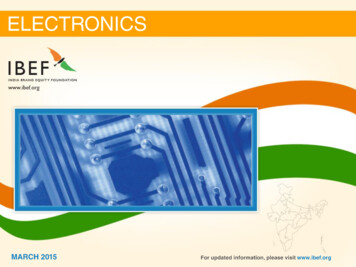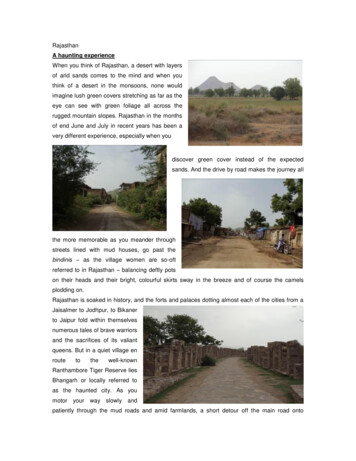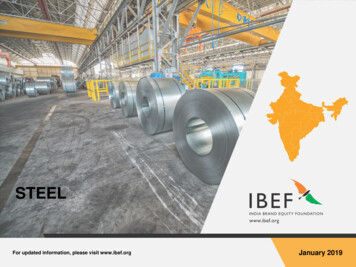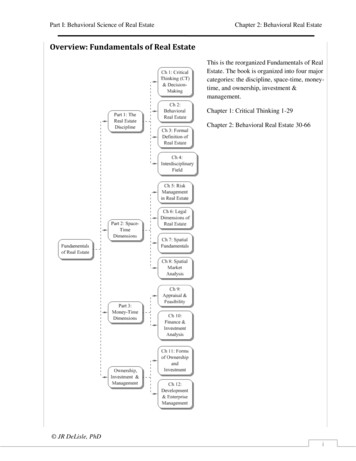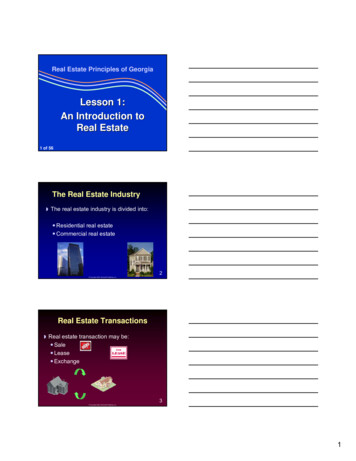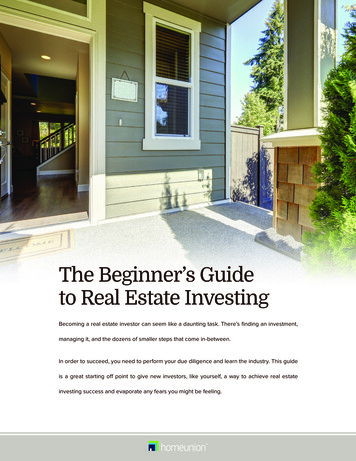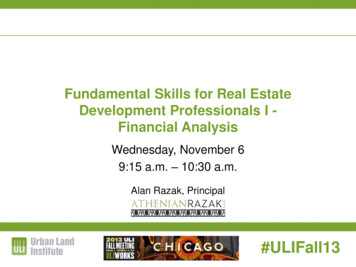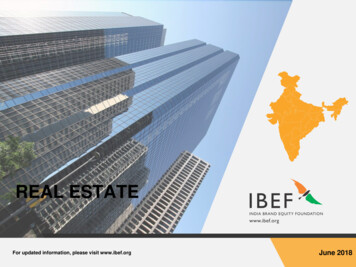
Transcription
REAL ESTATEFor updated information, please visit www.ibef.orgJune 2018
Table of ContentExecutive Summary . . .3Advantage India . . .4Market Overview and Trends . . .6Strategies Adopted . .14Growth Drivers .16Opportunities . . 24Key Industry Organisations . .28Useful Information . . .30
EXECUTIVE SUMMARY Real estate sector in India is expected to reach a market size of US 180 billion by 2020. Housing sector is expected to contribute around11 per cent to India’s GDP by 2020. Rapid urbanisation bodes well for the sector. The number of Indiansliving in urban areas is expected to reach 543 million by 20251. Morethan 70 per cent of India’s GDP will be contributed by the urbanareas by 2020.India’s real estate market (US billion)2001001265002015 4th largest sector in terms of FDI inflows. FDI in the sector1 stood atUS 24.67 billion from April 2000 to December 2017. FDI in thesector is estimated to grow to US 25 billion by FY22. Government of India’s Housing for All initiative is expected to bringUS 1.3 trillion investments in the housing sector by 2025.1801502020FUrban Population in India1 Cumulative FDI inflows since April 201825.2252524.824.624.6724.4FY18*FY22 E*Notes: E – estimated; * from April 2000 to December 2017, 1Construction developmentSource: Ministry of Tourism, KPMG, World Bank, Census 2011, EY – India’s Growth Paradigm 2017, Credai-JLL report, 1United Nations World Urbanization Prospects 20183Real EstateFor updated information, please visit www.ibef.org
Real EstateADVANTAGE INDIA
ADVANTAGE INDIA Demand for residential properties hassurged due to increased urbanisation andrising household income. India is among thetop 10 price appreciating housing marketsinternationally. Growing requirements of space from sectorssuch as education and healthcare, ecommerce and logistics. Warehousing space is expected to reach 247million square feet in 2020 from 140 millionsquare feet in 2017. Investments of Rs50,000 crore (US 7.76 billion) are expectedin India’s warehousing between 2018-20. About 10 million people migrate to citiesevery year. 35 per cent of the population is in youngage bracket (15-35 years). Growing demand of energy efficient andenvironment friendly architecture. Growing economy driving demand forcommercial and retail space.ADVANTAGEINDIA During April 2000 to December 2017,FDI inflows in construction development inIndia stood at US 24.67 billion andaccounted for 6.71 per cent of total FDIinflows into the country. Private equity investments in Indian realestate increased 15 per cent year-on-yearin January-March 2018 to Rs 16,530 crore(US 2.56 billion). The government has allowed FDI of up to100 per cent for townships and settlementsdevelopment projects Under the Housing For All scheme, 60million houses are to be built which include40 million in rural areas and 20 million inurban area by 2022 Real Estate Bill was passed in March 2016to establish a real estate regulatoryauthority for regulating and promoting thesectorSource: KPMG, Report on Real Estate Sector in India – Corporate Catalyst India Pvt Ltd, Department of Industrial Policy and Promotion, USGBC, JLL India, Cushman & Wakefield5Real EstateFor updated information, please visit www.ibef.org
Real EstateMARKET OVERVIEWAND TRENDS
SEGMENTS IN THE INDIAN REAL ESTATE SECTORResidential space Residential segment contributes 80 per cent of the real estate sector. New housinglaunches across top seven cities in India increased 27 per cent year-on-year inJanuary-March 2018. Few players with presence across IndiaCommercial space Office space demand in the country increased 23 per cent year-on-year in JanuaryMarch 2018 with office space absorption at 11.4 million square feet during the quarter. FDI in multi brand retail to boost demandReal estatesectorRetail space In 2017, new retail space of 6.4 million has finished and supply of around 20 mn sq ft isexpected in 2019. Between 2015 and March 2018, the retail segment in Indian realty attracted privateequity investments of around Rs 5,500 crore (US 853.4 million) up to March 2018.Hospitality spaceSEZs The country has 406 approved hotels with 31,944 rooms.* As of December 2017, the government had formally approved 423 SEZs, of which 222are in operation. Majority of the SEZs are in the IT/ ITeS sector.Notes: SEZ - Special Economic Zone. IT - Information Technology, ITeS - Information Technology Enabled Services,*as of Dec 20,2017Source: KPMG Cushman and Wakefield, Knight Frank, CRISIL, Ministry of Tourism, JLL India, ANAROCK Property Consultants, Colliers Research7Real EstateFor updated information, please visit www.ibef.org
INDIAN REAL ESTATE IS A LARGE, GROWINGMARKET Real estate sector in India is expected to reach a market size of US 180 billion by 2020 from US 126 billion in 2015. Increasing share of real estate in the GDP would be supported byincreasing industrial activity, improving income level andurbanisation Mumbai and Bengaluru have been rated as the top real investmentdestinations in Asia The government also launched 10 key policies for real estate sectorin 2016, namely:Market size of real estate in India (US billion)200180180160140 Real Estate Regulatory Act120 Benami Transactions Act100 Boost to affordable housing construction Interest subsidy to home buyers Change in arbitration norms Service tax exemption Dividend Distribution Tax (DDT) exemption Goods and Services Tax Demonetisation PR for foreign investors12680604020020152020Notes: CAGR - Compounded Annual Growth Rate; F – Forecast, Information is as per latest data availableSource: KPMG, Report on Real Estate Sector in India – Corporate Catalyst India Pvt Ltd, CBRE8Real EstateFor updated information, please visit www.ibef.org
WITH SIGNIFICANT ROOM FOR FURTHER GROWTH4034.13518.78101014.819.715.11521.72026 Government’s plan to build 100 smart cities would reduce themigration of people to metro and other developed cities.20.52519.3 Relaxation in the FDI norms for real estate sector has been done toboost the real estate sector26.730.13018.4 Significant increase in real estate activity in cities like Indore, Raipur,Ahmedabad, Jaipur and other 2-tier cities; this has opened newavenues of growth for the sectorUrban-rural housing shortage (million)34 The urban housing shortage in India is estimated at around 10million units* which is being addressed through Pradhan MantriAwas Yojana (PMAY), Urban, under which 1,427,486 houses havebeen sanctioned in 2017-18. In May 2018, construction of additional150,000 affordable houses was sanctioned under the al2015Notes: : E – Estimates, * As of November 2017 , 1 till December 08, 2017Source: : Ministry of Housing and Urban Poverty Alleviation, RBI, CRISIL9Real EstateFor updated information, please visit www.ibef.org
DEMAND FOR RESIDENTIAL SPACE EXPECTED TOGROW SHARPLYScenarioKey Drivers Alocalised,fragmentedmarketpresentsopportunities for consolidation with only few large,pan-India players such as DLF and Unitech More foreign players might enter the market as FDInorms have eased Furthermore, norms on land acquisitions is expectedto be relaxed Rapid urbanisation Growth in population Rise in the number of nuclear families Easy availability of finance Repatriation of NRIs and HNIs Rise in disposable incomeCumulative Housing Demand-Supply in Top 8 Cities (‘000 leTrends NCR is expected to generate maximum demand inMIG and HIG category followed by Bengaluru Developers now focussing on affordable and midrange categories to meet the huge demand India jumped 13 spots in Knight Frank’s GlobalHouse Price Index to reach 9th position in Q22017.1,982LIG2505001000150020002500Notes: LIG – Low Income Group, MIG - Middle Income Group, HIG - High Income GroupSource: : Cushman and Wakefield10Real EstateFor updated information, please visit www.ibef.org
METROS DRIVING DEMAND FOR COMMERCIALSPACEDemand for commercial space in top 8 cities (million sq ft) Scenario Few large developers with a pan-India presencedominate the marketOperating model has shifted from sales to a leaseand 0 Key DriversRapid growth in services sectors: IT/ITeS, BFSI andTelecom5 Rising demand from MNCs0 Demand for office space in Tier 2 citiesCity-Wise Commercial Space Demand (million sq ft) 2013-1715134AhemdabadCo-working space in top eight cities crossed 8million square feet in April 2018.8Bengaluru 16ChennaiBusiness activity shifting from CBDs to SBDs, Tier 1to Tier 2 cities25Hyderabad 3226KolkataMumbai, NCR and Bengaluru accounted for 60 percent of total office space demand in India in 2017.Mumbai 35302520151050NCRCommercial office stock in India is expected to cross600 million square feet by 2018 end.PuneNotableTrends Notes: MNC - Multinational Corporation, BFSI - Banking, Financial and Insurance Services, CBD - Central Business District, SBD - Special Business District, NCR - National Capital RegionSource: Cushman and Wakefield11Real EstateFor updated information, please visit www.ibef.org
RETAIL SPACE LIKELY TO SEE STRONG GROWTHScenario Currently, retail accounts for a small portion of theIndian real estate market Organised retailers are few and the organised retailspace is mostly developed by residential/officespace developersNumber of New Malls in India300250246Key DriversNotableTrends Booming consumerism in India Organised retail sector growing 25-30 per cent annually Entry of MNC retailers India’s population below 30 years of age havingexposure to global retail are expected to drive demandfor organised retail150 NCR accounts for about 49 per cent of the totalupcoming mall supply100 Absorption across retail malls in top seven citiesincreased 69 per cent year-on-year in JanuaryMarch 2018.50 Private equity investments in Indian retail assetsincreased 15 per cent in CY 2017 to reach US 800million. During January-March 2018, private equity investorsinvested Rs 950 crore (US 147.4 million) intoIndian ource: : Cushman and Wakefield, CBRE, JLL India, Real estate intelligence service (JLL)12Real EstateFor updated information, please visit www.ibef.org
HOSPITALITY MARKET TO WITNESS LARGEINCREMENTAL CAPACITY Scenario NCR and Mumbai are by far the biggest hospitalitymarkets in India, followed by Bengaluru, Hyderabadand ChennaiBesides hotels, the hospitality market comprisesserviced apartments and convention centresTrend analysis (stock - no of rooms) (‘000)140120100114118120201520162017100808260Key Drivers A robust domestic tourism industry The increasingly global nature of Indian businessesboosting business travel 402002013Tax incentives for hotels and higher FSI2014Occupancy Vs. Stock 64%62%60%58%Ahemdabad19KolkataGovernment initiatives to promote tourism in Tier 2and Tier 3 cities is generating significant demand forhotels in such cities, especially for budget hotelsNCR 36ChennaiServiced apartments appear particularly attractivewithin the hospitality spaceBengaluruNotableTrends 4035302520151050OccupanyNotes: FSI - Floor Space Index, E - estimatesSource: : Cushman and Wakefield13Real EstateFor updated information, please visit www.ibef.org
Real EstateSTRATEGIESADOPTED
STRATEGIES ADOPTED Having a diverse portfolio of residential, commercial and township developmentsDiversified portfolio Companies have projects in various strategic geographic locations in order to diversify risks Focus on the growth of lease business Housing finance companies and private equity companies have started focusing on affordable housing.BackwardintegrationMerger andAcquisitionsRisk managementin land sourcing An architectural, structural and interior studio and a metal and glazing factory Interiors and wood working factory and a concrete block making plant In May 2018, Blackstone Group acquired One Indiabulls in Chennai from Indiabulls Real Estate for around Rs 900crore (US 136.9 million). In 2017, 62 M&A deals worth US 1.46 billion were witnessed in India’s real estate sector. Joint Venture with land owners instead of amassing land banks. For e.g.: Oberoi Realty, Mumbai based realty firmadopted this strategy while entering the NCR region Revenue, area and profit sharing agreement with the land owner Outsourced support functionsSuperior execution Focus on delivery capability Development of world class infrastructure Rationalising costsSource: Aranca Research, Livemint, Economic Times15Real EstateFor updated information, please visit www.ibef.org
Real EstateGROWTH DRIVERS
REAL ESTATE BEING DRIVEN BY POLICIES ANDGROWING ECONOMYGrowth in tourismEpidemologicalchangesGrowth driversEasier financing17Real EstateUrbanisationGrowing economyPolicy supportFor updated information, please visit www.ibef.org
ECONOMIC GROWTH ALONG WITH GROWINGURBANISATION IS BOOSTING REAL ESTATE DEMANDPopulation breakdown of India (million)6.00%4.00%2.00%Advanced EconomiesEmerging EconomiesIndiaChinaFY 2019FFY 2018FFY 2017FY 2016FY 2015FY 2014FY 2013FY 2012FY 2011FY 20100.00% The Indian economy experienced robust growth in the past decadeand is expected to be one of the fastest growing economies in thecoming years Demand for commercial property is being driven by the country’seconomic 18EReal GDP growth rates of major economiesRural India’s urban population is expected to reach 543 million by 2025from 461 million estimated in 2018*. Government initiatives such as various urban developmentpolicies and programmes (e.g., JNNURM) are expected tocontribute to enhanced urbanisation. By 2022, real estate and construction sec
Indian real estate market Organised retailers are few and the organised retail space is mostly developed by residential/office space developers Scenario NCR accounts for about 49 per cent of the total upcoming mall supply Absorption across retail malls in top seven cities increased 69 per cent year-on-year in January-March 2018. Private equity investments in Indian retail assets increased 15 .


